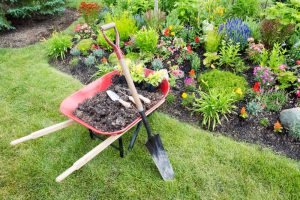As winter approaches, it’s time to prepare your outdoor spaces for the coming frigid temperatures. You may have extensive hardscaping features such as fencing, decking and constructed pathways. Or, you could have a patio fitted out for entertaining with furniture, grills and electronic devices such as TVs and stereo systems. Either way, it all needs to be cleaned and secured from the winter elements.
 Even if your outdoor space merely consists of a small table and a few lounge chairs, you’re still going to need to prepare your lawn and garden areas for the coming season. To accomplish this, it’s a good idea to have a systematic plan of action to follow to ensure your outdoor spaces will be fully functional when the spring thaw arrives. It starts with a complete fall cleanup before taking steps to preparing your garden for winter in New Jersey.
Even if your outdoor space merely consists of a small table and a few lounge chairs, you’re still going to need to prepare your lawn and garden areas for the coming season. To accomplish this, it’s a good idea to have a systematic plan of action to follow to ensure your outdoor spaces will be fully functional when the spring thaw arrives. It starts with a complete fall cleanup before taking steps to preparing your garden for winter in New Jersey.
Lawn Preparation
The first thing you’re going to want to do is fertilize your lawn sometime between the end of October and mid-November. This will help ensure that your grass will be green and lush come spring. Be sure to choose a fertilizer with a balanced mixture of potassium, nitrogen, and phosphorus. Fall is typically your lawn’s peak growing season due to the cool temperatures.
Make sure your last mowing during late fall allows for a length of grass no more than two inches high. Leaving your lawn longer than that can invite mold and root damage, since the snow tends to flatten the grass. Conversely, having it shorter than two inches allows for the sun and cold winter winds to damage your lawn.
Finally, it’s critical to make sure you’ve removed all leaves and debris of any kind from your grass before the first snowfall, as this is a primary method for pathogens and disease to potentially infect your lawn. If you’re hesitant in any way in not doing any of this yourself, don’t forget that you can always consult with a lawn and garden care specialist.
Preparation of Trees, Plants, and Shrubs
Chances are you have a lot invested in the foliage that adorns your property. While the steps in preparing them for winter conditions can be based upon the variety and types of plants you have, here are some key points to follow to keep them healthy and safe.
- Watering: Fall is a time to make sure your trees, plants, and shrubs are watered thoroughly before going dormant for the winter months. Water them regularly until the ground freezes. Failure to do so can cause unexpected browning of leaves once spring arrives.
- Perennials: You have a choice to either cut them down or leave them to become mulch. Prune them to help keep a neat appearance for your lawn, or let them turn into mulch that can be beneficial to the root systems.
- Pruning: You’ll want to prune any areas that might pose a danger of damaging your home or other structures as a result of heavy snowstorms. It’s imperative that you do this before the onset of snowy conditions. Once trees become dormant, it can make pruning easier because you’ll have a better visual sense of the growth patterns of the trees.
Protecting Decks, Fences and Other Wood Hardscape Features
The sun, moisture, and dirt accumulated on wood during the months preceding winter need special attention. A thorough cleaning and stripping away of damaged finishes is the first step to prepare them for winter. Preferably, do this no later than early November.
Once cleaned, your best bet in protecting them from excessive moisture from snow and ice will be to apply water repellant sealant. This will go a long way in preventing any cracks and splitting.
Don’t Forget Driveways and Hardscape Pathways
Just like wood structures, pavers, stonework, asphalt, and concrete are susceptible to damage from harsh winter conditions. Be sure to address any existing cracks in driveways and pathways with caulking or sealers designed for such purposes. Apply a sealer once the repaired cracks have dried.
Preparing Outdoor Furniture and Cushions
Many property owners store their deck and patio furniture during winter. Mistakes are made in this regard if the furniture and any cushions that go with them do not receive a good cleaning. The type and method of cleaning are dependent upon the materials involved.
- Wood furniture: Loosen dirt and grime with a dry brush followed by sandpapering over any rough areas. Wash the furniture with soapy water. Rinse and, once dried, coat and rub with teak oil.
- Metal furniture: Use a power stream from a hose to help loosen dirt and grime. Use a scrub sponge dipped in soapy water to remove any remaining debris. Rinse and dry.
- Wicker furniture: First, use a vacuum cleaner or a stiff brush to loosen grime and dirt. Then carefully clean the furniture with warm, soapy water. Rinse and dry thoroughly. Be careful with water on wicker, as it can cause it to warp.
- Cushions: Consult the labels, if available, as it may be that you can remove the fabric from the pillow and run it through your washing machine and dryer. When this is not possible, use soap and water to spot clean the cushions.
Of course, you’re going to want to also properly clean your grill and any electronic devices before wrapping them, along with the clean furniture, in heavy-duty covers.
Remember, if you have any questions or concerns about any of these recommended steps, don’t hesitate to contact a lawn and garden professional. Not only can they provide sound advice, but they can also take the whole worry of preparing your special outdoor spaces off your hands.
Thank you for reading our blog! How can we help you? Contact us today.




